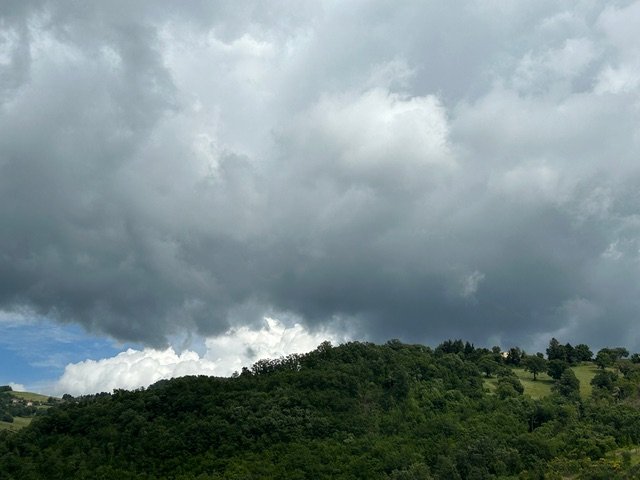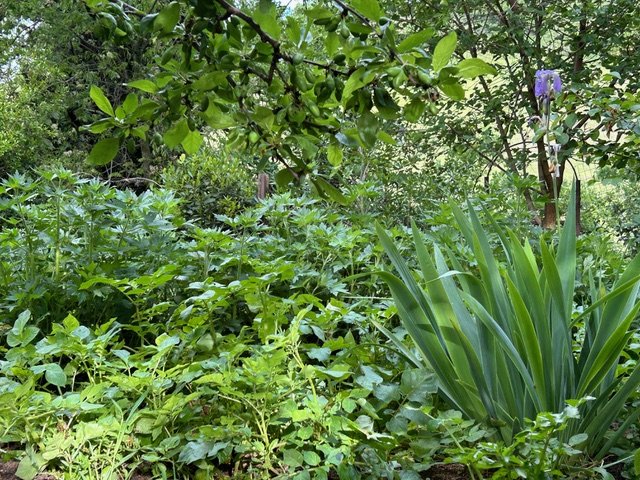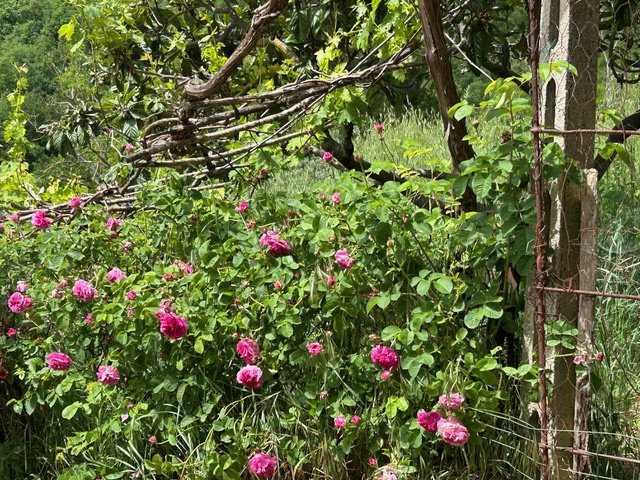Finding Our Way Home Part III: Finding Community
A memory: I am a kid. Perhaps seven or eight years old. Climbing an apple tree in my backyard. My dad can't reach the apples on the higher branches and with his encouragement I am scaling the tree using all four appendages. I become a crouching animal. But the higher I go and the more tightly I cling to the limb, I become part of the tree. It is exhilarating. I am somewhere between the worlds of plant and animal, wild and tame. I couldn't put a word on the feeling then. Now I can... Freedom.
When we speak of community today we are referring to the dictionary definition of a unified body of individuals. There is always a common interest, a common thread running through every community. For many of us our community may be our neighborhood or village. Or perhaps the people with whom we work. Or a religious or spiritual group. We find common ground in sports and the arts and our musical preferences. But, in general, we think of community in human terms.
My neighbors and the neighboring village are a major support in my life. We are all farmers and I might refer to them as my community. But there is another definition of community (from The Oxford English Dictionary): a group of animals or plants in the same place; a group of organisms growing or living together in natural conditions or occupying a specific area... For me, the mountain on which I live, the animals and plants, the climate, the river and underground spring… actually the land and all it encompasses... this is also my community. And like the other communities of which I am a member, we have a reciprocal arrangement. We support one another. But unlike other communities, this one supplies almost all my needs. It is no small thing that the land community feeds me and my family, provides an income, gives us fresh water and shelter and heat. I wake up to beauty—a lush green mountainside twelve months a year. I hear birdsong instead of car alarms. There is no traffic, no commute. I am home in so many ways.
On the mountainside, smallholdings are carved into the forest, hugged by wilderness. I share the forest and fields with countless animals and plants, untold numbers of organisms, most of whom I don't know. It was not until we moved here that I finally got it, that I understood what it meant to grow food in a partnership with nature, something I had given lip service to for years. I learned - am still learning - the ways in which the land community cares for itself and how it is the definition of sustainability. I gave up the illusion that I was the boss of the farm when I became a member of the land community. I have little to no control of what is happening. I have a general idea of what I hope to do… hubris on my part, of course. Anything I plan is open to a veto by the natural world. But there is no day to day 'to-do' list. The work is dependent on the amount of sunshine or rain, the length of the day, the temperature and what seems necessary after I am awake and have had my tea. The food we grow is dependent on what will prosper in the current climate, right now, this month. We can't plan for it. In general, I don't even choose the plants. We work with the ones which have grown here for centuries and the ones which are adapting robustly to the changing climate. The only 'must do' that comes up generally concerns an animal. We share the land with wolves, foxes, wild boar, hawks, and weasels. They are (mostly) helpful neighbors but their presence means that our birds and beasts go into the barns before dusk and are let out for breakfast after the sun is up. Tending to this bookmarks our daylight hours. But it is the weather and the season which determine the specific tasks for the day. We do not plan so much as respond.
Iris and potato plants in front with motherwort behind and a plum tree above
I got a divorce from the agricultural model when we moved here. I know exactly when I joined the land community. It was the day I ran outside to grab some lettuce for our lunch. It was raining and I was in the garden, cutting greens, soaking wet, bare feet in mud. And it felt just right. I was relishing the much needed rain just like the plants.
Only in the last moment of human history has the delusion arisen that people can flourish apart from the rest of the living world. E.O. Wilson
What has happened to our kind? We have lost our way, lost our connection with the living earth of which we are a part. The detachment ramped up with the spread of agriculture. We wrote a mythology to become superior to the plants and animals, to tame them and contain them and breed or beat out their instincts. We named ourselves the conquerors of the natural world. But we are also animals, just animals who climbed down from the trees, our needs sublimated. Nothing in our genetics has changed. We do our hunting now in video games and our gathering on Amazon. But we are always seeking, starving emotionally, needing a connection with the living planet.
We need to live among the trees and grasses and animals. That is why our homes, our balconies and backyards and windowsills are spilling over with plants and even small trees. We keep caged songbirds. And aquaria full of fish. We have dogs we walk three times a day. We play tapes of the wind in the trees to fall asleep. We came down from the trees onto the savanna and into cities but we are still tethered to our ancient DNA. And the fewer the trees and plants, animals and water in our immediate world—the elements of our shelter, the source of our food, our connection to the natural world—the more unbalanced we feel.
In the land community everything is connected, interdependent. We are all part of a great circle. The pea vines are just about finished. The pods are in the compost, the chickens will eat the vines. When I cut down the artichoke leaves for the season, they will go to the donkeys for an evening treat. Almost every branch and vine pruned in the fall will be propagated—stuck in a pot of soil or directly into the earth. In the spring the new trees and vines will have roots and will be ready to be moved to individual pots and sold or planted on the land. All our waste and the waste from the animals becomes compost. The manure the animals leave behind in the fields nourishes the future grass which they will eat. Bringing the chickens our leftovers, giving them unlimited greens from the gardens and letting them free range to eat worms and weeds and bugs keeps them healthy with nutritious, better tasting eggs. The plants, shrubs, vines, and trees flower and set seed, the seeds drop to the ground and form new plants. A portion of cloves from the harvested garlic are put back in the soil to form the next crop. The same with the ends of all the onions. For every mound of potato I dig, one potato is left in the ground to grow next season's potatoes. And when a plant or animal dies, it is buried and nourishes the soil and the next generation of plants. There is no waste.
These are not my ideas. I have been watching what Nature does.
A wild rose growing on an old fence in the field
The house in which we live is surrounded by trees; ancient oaks, cypresses, and pines. They are many stories taller than the house. And because I wanted a kitchen garden right outside the kitchen door, it seemed logical to work with what was there. It meant taking the forest culture as the model for how our food would be grown. All forests have numerous vibrant and interconnected layers. The tallest trees—the overstory or canopy layer—require the most light. Just below are the understory trees, smaller trees growing in the shade of the canopy. Shrubs and brambles, are beneath the understory. Herbaceous and evergreen woodland plants grow just above the forest floor, which is blanketed in leaves and downed wood. The rocks and wood and debris are covered with moss, lichen, and fungus. Animals of all sorts make their homes in the all the layers. And within the soil is another entire universe: a densely interconnected underworld ecosystem of all the detritivores—the animals, fungus and microorganisms all making a living among the tree and plant roots. These organisms break down the animal and plant waste and recycle it as nutrition for the entire forest; they are the plumbing system, waste management, and food supply.
Sage, artichoke, calendula, comfrey, currant bushes, a small pomegranate tree, with laurels and a cypress behind. Salad greens and edible weeds cover the ground.
Working with the forest, we planted an understory of a scattered fruit trees just below the old trees. We made soil from plant debris, rotted leaves, and heavily-manured animal bedding. Chickweed and wild chicory moved in as soon as they caught wind of the rotting manure. Inspired, I added to that lettuce, chard, and endive seeds from packets I purchased at the local feed store. But then the plant community took over. Bittercress and lamb's quarters arrived on the wind (or in the manure) and made themselves at home. A friend brought over a few nettles roots. (They didn't like where I planted them and self-seeded to another part of the garden.) They were followed by more wild edible greens—sorrel, borage, and purslane. And medicinal herbs—saint john's wort, mugwort, burdock, yarrow... The plants from the heirloom seeds I purchased paid attention and began to compete, flowering and scattering their seeds about. All together they became an herbaceous forest floor, a self-perpetuating cover crop and plant community (click here for recipe) sucking up the rainwater during our deluges and holding the moisture in the soil during the dry summers. Once the permanent cover crop was established, I popped in the perennial plants (like artichokes and currant bushes) and the annuals (like tomatoes in the summer and broccoli in the fall). It is important to mention that after years of planting, the seeds that I work with are the ones from the plants which survived and prospered the previous season.
Fava beans under a plum tree, the hillside behind is planted with rosemary
The plants are a jumble of diverse but compatible species, a community of numerous edible, flowering and medicinal plants. With different root depths and nutritional needs, competition for resources is kept to a minimum and a fair amount of trading of water and minerals goes on. In general, after the initial planting, everyone decided for themselves who would be where. And I am convinced that I have very few insect problems as a result of a diverse culture.
There are unexpected snowstorms, the river overflows some years. April and May were all about rain and then, so far, in June, nothing but sunshine and heat. The natural world does not consult me about her plans and I accept that change is part of the cycling seasons, part of growth, and part of the increasing climate chaos. But though a late frost meant no apricot harvest this year, we are having an amazing cherry season and the plums are already set on the trees. I don't know about the olives. Being part of a large and diverse plant community means that there is always a harvest of something, there is always enough. I just don't have the illusion that I know what it will be or that I can make it happen. It is enormously liberating to count on the land community, to live within it. And they can count on me to respect and protect them. The longer I am part of this woodland, the more I return to natural ways, the more satisfying my life is. I live somewhere between wild and tame. But what I feel is freedom.
Heaven is under our feet as well as over our heads.
Henry David Thoreau
© www.thesubversivefarmer.net June 11th 2025
In a previous lifetime, Zia Gallina worked as a botanist for the National Parks Service, on the C&O Canal outside of Washington D.C. (lecturing on wild indigenous and naturalized medicinal and culinary plants). She was also an adjunct professor teaching biology and environmental science at American University, Washington D.C. But she has always been a champion of small-scale biointensive farming, tagging behind Mother Nature, trying to stay as close as she can get.







